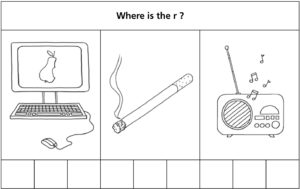Preliminary remarks
The primary context of the following exercises is the introduction of a certain sound as part of the alphabetization in the first language (at the end of the 1st grade or beginning of 2nd grade). Parallel to learning the typeface, the correct, natural pronunciation has to be practiced as well. It is entirely possible to begin many pronunciation exercises in kindergarten already, or to repeat them in upper level classes if uncertainties continue to persist in this regard.
a) Repetition exercises
- The instructor has prepared (or memorized) a list of words which contain the respective sound. S/he sits with one or several students and clearly pronounces the words. The students then repeat them individually and clearly, one after the other.
- Variant: the role of the instructor can also be assumed by an older student who has an impeccable pronunciation.
b) Exercises with the pocket mirror
- A pocket mirror can help to raise awareness of how sounds are formed. After the teacher has clearly demonstrated the formation of a sound, e. g. the shape of the mouth to create the /m/ and the /n/, the students try to emulate the articulation and check themselves in the mirror. The exercise lends itself well for partner work with an older student.
- This exercise may not be suitable for certain sounds (e. g. /d/ – /t/). What may help in this case, is to feel with the hand the different degrees of exhaled air pressure (more air with /p/ than with /b/ etc.)
c) Accoustical identification and differentiation exercises
- Identification exercises: the instructor (or an older child with native ability) has a list of words which contain, or do not contain, the respective sound. S/he reads the words to the students. The students raise their hands when words that contain the sought-after sound are articulated, and refrain from doing so with the other words.
- Differentiation exercises (e. g. b – p; d – t; ć – č): one part of the word includes one of the two differentiating sounds (e. g. /b/); the other part contains the other sound (e. g. /p/). The students must indicate which sound (e. g. by raising the left or right hand or holding up a little card, containing the letter b or p, respectively).
d) Exercises with pictures
(analog to exercise c)
- Identification exercises: the students receive a sheet of paper with many pictures of objects, which may, or may not contain the respective sound. They must circle all objects which contain the sought-after sound. They then must correctly pronounce the words.
- Differentiation exercises: (e. g. b – p; d – t; ć – č): some of the depicted objects contain one of the sounds to be differentiated (e. g./b/); the others ones contain the other sound (e. g./p/). The students circle the pictures in either red or blue, according to the differentiated sounds. They then must correctly pronounce the words.
- Variants: the students sit in a circle. On the floor in the middle there are two sheets of paper. They are marked with a letter representing a sound; e. g. one of them spells “D, d”, and the other one “T, t”. Each child receives 5–7 little cards with pictures. One after the other, they show one of the cards. If the card contains one of the sounds, they may place it on the corresponding paper, otherwise they are placed on a blank sheet. (Picture cards can either be bought, or self-made with the help of older students.)
e) Mark the initial, the medial, or the final syllable
- The students receive a paper with 12 pictures of objects. The respective sound may be at the beginning, in the middle, or at the end of the word. Below each object there are three fields. The students must check the corresponding field to indicate whether the sought-after sound is at the beginning, the middle, or at the end of the word. (see illustration).







